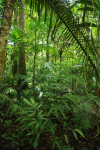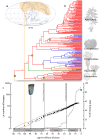Origin and global diversification patterns of tropical rain forests: inferences from a complete genus-level phylogeny of palms
- PMID: 21679405
- PMCID: PMC3142250
- DOI: 10.1186/1741-7007-9-44
Origin and global diversification patterns of tropical rain forests: inferences from a complete genus-level phylogeny of palms
Abstract
Background: Understanding how biodiversity is shaped through time is a fundamental question in biology. Even though tropical rain forests (TRF) represent the most diverse terrestrial biomes on the planet, the timing, location and mechanisms of their diversification remain poorly understood. Molecular phylogenies are valuable tools for exploring these issues, but to date most studies have focused only on recent time scales, which minimises their explanatory potential. In order to provide a long-term view of TRF diversification, we constructed the first complete genus-level dated phylogeny of a largely TRF-restricted plant family with a known history dating back to the Cretaceous. Palms (Arecaceae/Palmae) are one of the most characteristic and ecologically important components of TRF worldwide, and represent a model group for the investigation of TRF evolution.
Results: We provide evidence that diversification of extant lineages of palms started during the mid-Cretaceous period about 100 million years ago. Ancestral biome and area reconstructions for the whole family strongly support the hypothesis that palms diversified in a TRF-like environment at northern latitudes. Finally, our results suggest that palms conform to a constant diversification model (the 'museum' model or Yule process), at least until the Neogene, with no evidence for any change in diversification rates even through the Cretaceous/Paleogene mass extinction event.
Conclusions: Because palms are restricted to TRF and assuming biome conservatism over time, our results suggest the presence of a TRF-like biome in the mid-Cretaceous period of Laurasia, consistent with controversial fossil evidence of the earliest TRF. Throughout its history, the TRF biome is thought to have been highly dynamic and to have fluctuated greatly in extent, but it has persisted even during climatically unfavourable periods. This may have allowed old lineages to survive and contribute to the steady accumulation of diversity over time. In contrast to other plant studies, our results suggest that ancient and steady evolutionary processes dating back to the mid-Cretaceous period can contribute, at least in part, to present day species richness in TRF.
Figures



References
-
- Gentry A. Tropical forest biodiversity: distributional patterns and their conservational significance. Oikos. 1992;63:19–28. doi: 10.2307/3545512. - DOI
-
- Whitmore TC. An introduction to tropical rain forests. Oxford, UK: Clarendon Press; 1998.
-
- Hill JL, Hill RA. Why are tropical rain forests so species rich? Classifying, reviewing and evaluating theories. Prog Phys Geog. 2001;25:326–354.
Publication types
MeSH terms
LinkOut - more resources
Full Text Sources

